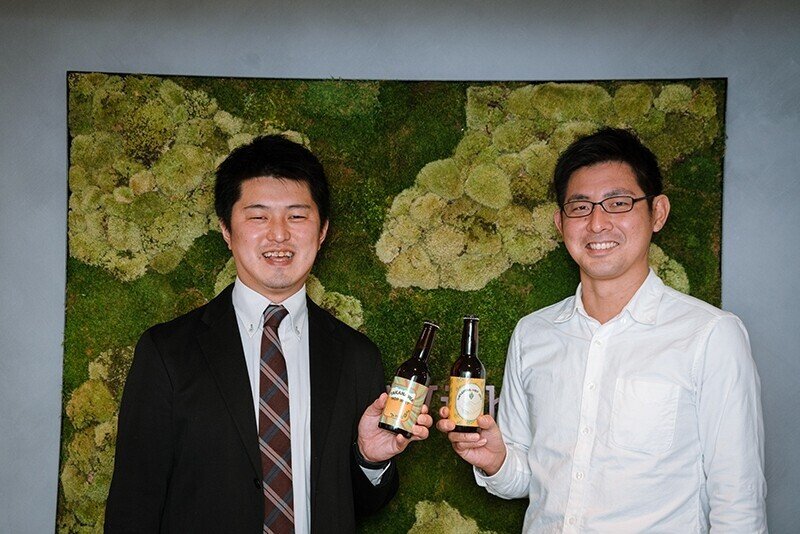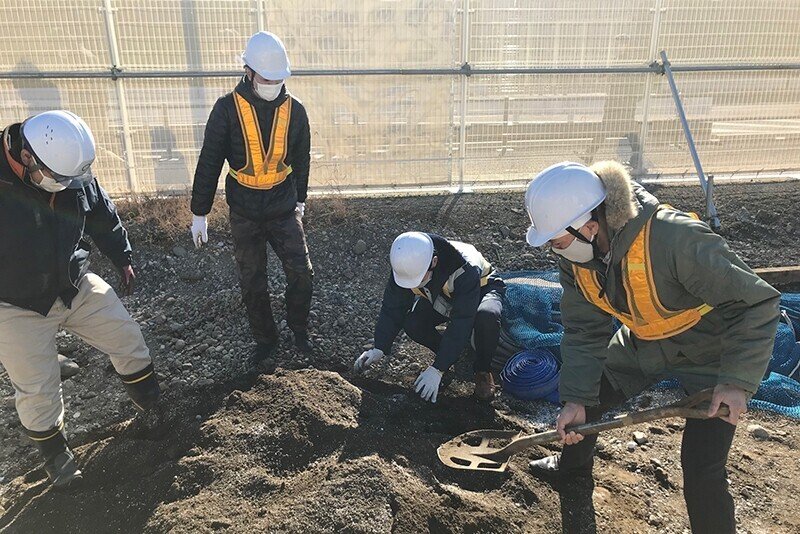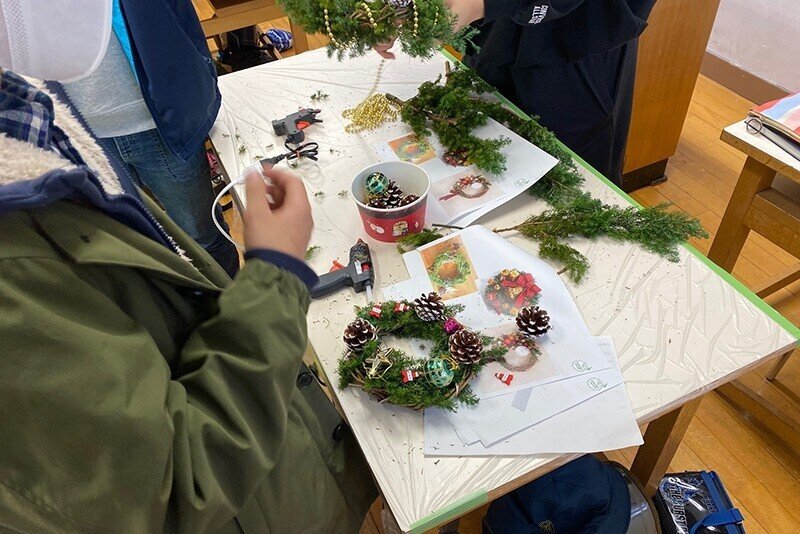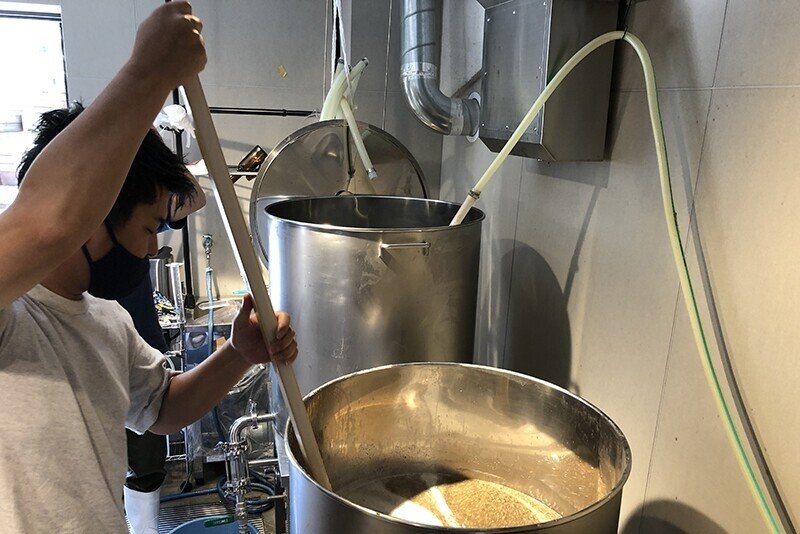
The 100% Takanawa hops beer debuts! Realizing a community that entrusts, carries on, and improves on its own
The TokyoYard Project, which is a part of the Shinagawa Development Project conducted by East Japan Railway Company around Takanawa Gateway Station, has initiated a hop cultivation activity called ”TAKANAWA HOP WAY” last year. The activity took place in the TokyoYard Building, the development base of the project, as its mainstay. In the first phase of the project, we have conditioned turned soils from the development work and planted the seedlings. They were then cultivated in cooperation with businesses (TOKYO TOWER Co., Ltd., HAPPO EN Co., Ltd., and Koru Workers Inc.) and schools (Tokai University Takanawadai High School and Middle School, Minato Ward Takamatsu Middle School, Minato Ward Mita Elementary School, and Meiji Gakuin University) which all reside in the Takanawa Gateway Station area, at respective locations.
We have ultimately harvested and brewed about 2.8 kg of hops from 80 planters, which amounted to 600 bottles of beer. At the ”Takanawa Hop Fest,” an event held at “Takanawa Gateway Fest 2021” in November of last year around Takanawa Gateway Station, the residents and people who were involved in the cultivation of the hops gathered to attend the unveiling and tasting session of ”TAKANAWA HOP WAY”, beer made with 100% pure Takanawa hops. The second phase of the activity is scheduled to start in March.
The purpose of this communal hop-growing activity is not only to grow hops and make beer but also to expand the circle of connection with local people in the process of collaboration and to form a community that can keep improving on its own.
What kind of responsibility should JR East, as a developer, fulfill to create a better everyday life with and for residents, or in other words, the foundation of a community? To discuss this topic, Higuchi, a member of the JR East Shinagawa Development Project Team sat down with Shogo Tanaka of TOHO-LEO Co.. Tanaka has been involved in the urban infrastructure development and the creation of liveliness through green infrastructure technology as well as the said hop-growing activity.

Kentaro Higuchi (on the left)
Shinagawa Life Style Promotion Unit (Planning), New Business Creation Division, Business Creation Headquarters, East Japan Railway Company.
Higuchi is in charge of the planning and management of events that promote local attractions, as well as collaboration with nearby schools.
Shogo Tanaka (on the right)
Cultural Engineering Division, TOHO-LEO Co.
Tanaka is in charge of local area management operations and the creation of green infrastructure to revitalize local communities through greenery.
Creating “opportunities for engagement” and a “greeting acquaintance”
Kentaro Higuchi (hereinafter Higuchi) :
In the summer of 2020, TOHO-LEO proposed that we start growing hops together. That’s how it all began. And we started with soil conditioning with the participation of local residents.
Shogo Tanaka (Tanaka) :
When we analyzed the soil at the construction site, we found that it was well-drained and suitable for hop cultivation. We are originally a manufacturer of soil conditioners, so we made the soil by blending our conditioner that suits the excavated soil.

Higuchi :
Collecting and conditioning the soil was a real challenge. We used heavy machinery to dig up the hardened soil, and then sifted it over and over again to remove large amounts of stones.
Tanaka :
It was amusing to see the JR team members working on such an operation in their suits and ties at first. There was even steam coming out of their suits.
Higuchi :
After the second time, everyone changed to coveralls. We realized that ”This is not the kind of work we can do in a suit”.

Tanaka :
I think that event gradually broke down the barriers between the members of TOHO-LEO and JR. I realized anew that collaborative work generates good communication. And that was something that we have placed importance on in the rest of the project as well.
Higuchi :
Absolutely. We had residents involved throughout the year, from planting the seedlings to cultivating, harvesting, and finally tasting the finished beer. Even the labels were designed by students majoring in wine laws at Meiji Gakuin University, which has a campus in Shirokane. We also invited the public to join in on the design and ultimately adopted two patterns of design. Beyond that, we made Christmas wreaths using hop vines grown at Mita Elementary School in Minato Ward and held a cooking class using hop yeast in cooperation with Takamatsu Junior High School in Minato Ward and “MuSuBu”, a showroom owned by Happo-en, which is a wedding hall in Shirokanedai. We also created recipes that can be easily prepared at home and they were well-received as well.


Tanaka :
In the course of the project, we often discussed the importance of how much “collaborative work we do on our own” was in the process. How can we increase the amount of communication by creating more and more “opportunities for engagement” before reaching the final result of hops (beer)?
We ended up making a delicious beer with a great-looking design, but the quality of the product was not that important. It didn’t matter if you could make a beer that tastes as good or has a better design than the beers in the existing market. The fact that we made beer on our own is priceless and can’t be compared.
Higuchi :
As Tanaka said, hops are just a means to an end. The goal we want to achieve is something more. As the new city is built in the Takanawa and Shirokane areas, JR, the developer, will become a member of the community through the process of making new things. At the same time, residents will communicate and connect. The purpose of this project was to create “greeting acquaintance” in an intangible aspect, and hops and beer were used to leave something tangible as proof of this connection.
It's not a community if you quit halfway through
Higuchi :
In recent years, the importance of ”community” has been pointed out more than ever before, and various initiatives are being attempted all over the country and even the world. As TOHO-LEO supports the formation of communities in various regions using greenery as a starting point, what role do you think the management side should play in forming communities and cultures?
Tanaka :
My answer is simple: never quit committing to the community. You can only create so many extraordinary events for the community and none of it matters in the end. The communal activities of large corporations get momentary attention, but it is more important to create an environment that generates casual everyday conversations. More than anything else, it is important to have a large number of conversations and many points of contact to generate them. Communication is more about quantity than quality. And it is not a community if you stop committing halfway through. A community is a history of everyday life and the accumulation of that very life.
Higuchi :
I myself fell in love with the city when I came in contact with the local people as an individual and was touched by their warmth. That is something nurtured beyond my ”efforts” as an employee of the company. And that’s why I would never want to disappoint these people. I think that interacting with the daily lives of the community as an individual ultimately leads to fulfilling the responsibility of the development side of a company like JR East to ”never quit”.
Tanaka :
The more a large corporation is involved in communal activities, the more it is necessary for the corporation to have a will that says “we will never stop committing to the community”. We need to structure a responsible organization where that same will adhere from the top to the employees in the field. What’s more, not only in terms of design, consultation, and space leasing, we need to make a long-term commitment to the management of the activities as well. These are the roles and responsibilities of the people who are trying to form a community.
And yet at the same time, as a company, we can't stay in the community forever, so we need to gradually switch over to playing a background role. When we think about who owns the community, it goes without saying that it belongs to the people who take root in the place. The strength of the people who bask in the breeze of the community is unmatched by us. It would be best if the activity became a self-managed festival for the local people to enjoy themselves. “While passing the torch to the people who will take charge of the place, we will not stop committing either”. Such attitude and action are necessary for our role.
Higuchi :
At the moment, TOHO-LEO and JR are leading the communal activities, but eventually, we would like to become a member of the community, working together with everyone as a company or an individual in the community, rather than JR as a developer of the area. In that sense, we would like to make this a self-improving activity.
What JR East can do to ”carry on”
Higuchi :
At the end of the day, we would like to create many points of contact and increase communication between us and the community. To achieve this, we believe that it is very important to have a ”face of JR” that serves as a contact point for the community. Naturally, there is a line or barrier between a development company like us and the local community at first. That is why it is necessary for JR East, the developer, to be a visible presence.
In terms of communal hop-growing activities, people have come to recognize me as ”the good old Higuchi from JR”. I feel that this is the result of me showing up everywhere, talking with people, working together, and getting to know each other as a front-line worker for the past year.

Tanaka :
At the same time, I believe it’s also difficult to continue the connections and relationships that have been built up.
Higuchi :
Yes. While a company like the size of JR East has the advantage of being able to commit long-term effort, it is possible that what has been built up over time can be easily reset due to, say, personnel changes. I think this is one of the major challenges in urban development and city planning in general.
In my case, since the predecessor handed over the project with great care, I firmly believe that we must not let this flow stop. Tanaka is right when he says ”You can't be in charge forever”. We need to create a system of inheritance within the company that embraces the thoughts and feelings behind the people who were involved in the project, and we need to pass on what we have fostered within ourselves as well. I believe that is how we can fulfill our ”responsibility to carry on”.
Communal hop-growing activities and future prospects
Tanaka :
After completing the first phase of this year-long project, what were the reactions of the local participants?
Higuchi :
No one in the community had ever grown hops before, so I think people were at a loss in the beginning. In the first phase, we made some suggestions so that people could participate comfortably, but gradually the participants began to actively express their opinions, and in the end, I feel that we achieved a very positive result.

There were many moments when the connections made there went beyond hop growing. For example, a school suggested that we do a class at school together in the future. One of the best results of the project is that it has already become one of the triggers for creating connections. After all, that was one of the objectives of the project to start with.
Tanaka :
But again, we need this circle of connection to keep expanding.
Higuchi :
That's right. We've already started talking to people for the coming phase. The first phase was a trial, and we contacted businesses and schools in the Takanawa area that we have already had relationships with. As for the second phase, we would like to expand the scope of the activity to include people who are rooted in the local community, such as store owners from shopping streets and the neighborhood.
Tanaka :
Neighborhood associations, shopping streets, and condominium association boards are all people who work on building continued community relationships daily, so it would be great if they could use hop growing as a vehicle for this.
Also, it would have been best to have the participants involved in the beer-making (brewing) as well, but due to the pandemic, this was not possible. We would like to incorporate more physical communication into the process. Ideally, we would like to go to Osaka with the local community to do the brewing.
Higuchi :
This is just my idea, but my ideal would be for the hop growing to spread on its own among residents beyond the original purpose of hop community activities, which is expanding the circle of organic connections.

Here’s what I imagine. Hop seedlings will be shared among residents, and hops will be grown all over Takanawa. Then the hops are harvested and brought to a brewery in the city, where they are made into beer. The beer is toasted in a park in the new city district, and the surplus is sold at local stores. The leftover bottles are reused for something else. I hope such a future comes where this kind of circulation becomes a specialty of Takanawa.
Tanaka :
It would be great to see a beer competition between neighborhood associations, shopping malls, and local communities one day.
Higuchi :
As a newcomer to the area, JR East would like to support the development of local communities by weaving together the small passions of individuals and the wishes of the residents into a project that will gradually become self-sustaining. We believe that the second phase of the project will be a turning point, so we would like to invite people from various regions to participate.
Interview and Edit by Takuya Wada
Photograph by Yutaro Yamaguchi
Translation by Keitaro Takama
Content Direction by blkswn publishers Inc.
#TokyoYard #TokyoYardPROJECT #TakanawaGatewayStation #urbandevelopment #Tokyo #hop #TAKANAWAHOPWAY #communication #community #communalhop -growingactivity #regional_co_operation #beer #beer -making #craftbeer
この記事が気に入ったらサポートをしてみませんか?
